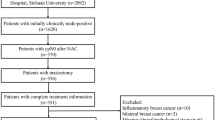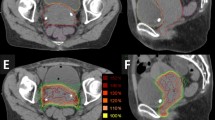Background:
2-year results of a German multicenter randomized trial showed that accelerated chemoradiation with MMC/5-FU to 70.6 Gy is more effective than accelerated radiation to 77.6 Gy alone at equivalent levels of acute and late radiation morbidity. Frequency, histopathology and impact on local tumor control of selective lymph node dissection were analyzed.
Patients and Methods: Between February 1996 and October 2000 at Tübingen University 42 randomized patients plus 45 non-randomized patients with stage III/IV M0 head and neck cancer were treated according to this protocol. After completion of hyperfractionated accelerated (chemo-)radiation a selective lymph node dissection was performed, if the primary tumor was in complete remission and clinical plus computed tomography proved residual lymph node disease. 17 of 38 patients with residual node metastasis underwent uni- or bilateral selective node dissection, the remaining patients had residual primary tumors, clinical deterioration or refused neck dissection.
Results: After a median follow-up 26 months, the Kaplan-Meier analysis showed a 2-year overall survival of 49%, disease-specific survival of 64% and loco-regional tumor control of 60%, respectively. 3-year loco-regional tumor control in randomized patients was 52% compared to 58% in non-randomized patients (log rank p = 0.23). 2-year loco-regional tumor control in stage cT4cN0 was 76% compared to 57% in cT2-4 cN1–3 tumors. Subgroup analysis of patients with involved nodes revealed a 2-year loco-regional tumor control of 74% after complete remission of primary tumor and neck disease, 53% after complete remission of primary tumor and partial remission of neck disease. In patients with selective lymph node dissection loco-regional tumor control was 62%. Histopathological examination showed viable tumor in eight of 17 patients.
Conclusions: Selective lymph node dissection of residual neck masses after completion of hyperfractionated accelerated radio-(chemo-)therapy is likely to contribute to loco-regional tumor control in advanced head and neck cancer.
Hintergrund:
Die multizentrische Phase-III-Studie (ARO 95-6) zur akzelerierten hyperfraktionierten Strahlentherapie ± 5-Fluorouracil/Mitomycin C bei lokal fortgeschrittenen Kopf-Hals-Tumoren konnte nachweisen, dass die kombinierte Radiochemotherapie bezüglich lokaler Tumorkontrolle und Gesamtüberleben wirksamer ist als die alleinige Strahlentherapie. Wir untersuchen Häufigkeit, histopathologisches Ergebnis und den Einfluss der selektiven Neck-Dissection auf die lokale Tumorkontrolle.
Patienten und Methoden: Zwischen Februar 1996 und October 2000 wurden in Tübingen insgesamt 42 randomisierte und 45 nicht randomisierte Patienten mit fortgeschrittenen Kopf-Hals-Tumoren im Stadium III/IV M0 nach diesem Protokoll behandelt. Nach Abschluss der akzelerierten hyperfraktionierten Strahlentherapie ± 5-Fluorouracil/Mitomycin C wurde eine selektive Neck-Dissection bei kompletter Remission des Primärtumors und partieller Remission der Halslymphknotenmetastasen angestrebt. Bei 17 von 38 Patienten mit residuellen Halslymphknotenmetastasen wurde eine uni- oder bilaterale selektive Neck-Dissection durchgeführt. Bei 21 Patienten wurde die Neck-Dissection wegen partieller Remission des Primärtumors, klinischer Verschlechterung oder Ablehnung durch den Patienten nicht durchgeführt.
Ergebnisse: Nach einem medianen Follow-up von 26 Monaten betrugen das 2-Jahres-Gesamtüberleben 49%, das krankheitsspezifische Überleben 64% und die lokoregionäre Tumorkontrolle 60% (Kaplan-meier-Analyse). Für cT4-cN0-Tumoren betrug die lokoregionäre 2-Jahres-Tumorkontrolle 76% im Vergleich zu 57% bei cT2-cN1–3-Tumoren. Es bestand kein Unterschied bezüglich der lokoregionären Tumorkontrolle zwischen randomisierten und nicht randomisierten Patienten. Bei kompletter Remission des Primärtumors und der lokoregionären Lymphknoten betrug die 2-Jahres-Tumorkontrolle 74%, bei partieller Remission der lokoregionären Lymphknoten 53%. Nach partieller Remission der lokoregionären Lymphknoten und selektiver Neck-Dissection betrug die 2-Jahres-Tumorkontrolle 62% (Abbildung 3). Die histopathologische Aufarbeitung wies bei acht von 17 Patienten vitale Tumorzellen nach.
Schlussfolgerungen: Die selektive Neck-Dissection von residuellen Halslymphknotenmetastasen nach akzelerierter hyperfraktionierter Strahlentherapie ± 5-Fluorouracil/Mitomycin C bei lokal fortgeschrittenen Kopf-Hals-Tumoren kann möglicherweise zur lokalen Tumorkontrolle beitragen.
Similar content being viewed by others
Author information
Authors and Affiliations
Additional information
Received: November 8, 2001; accepted: April 18, 2002
Rights and permissions
About this article
Cite this article
Hehr, T., Classen, J., Schreck, U. et al. Selective Lymph Node Dissection Following Hyperfractionated Accelerated Radio-(Chemo-)Therapy for Advanced Head and Neck Cancer. Strahlenther Onkol 178, 363–368 (2002). https://doi.org/10.1007/s00066-002-0965-0
Issue Date:
DOI: https://doi.org/10.1007/s00066-002-0965-0




